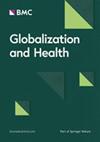不平等的经济发展是否会导致医疗资源的不公平分配?来自中国 2001-2020 年的证据
IF 5.9
2区 医学
Q1 PUBLIC, ENVIRONMENTAL & OCCUPATIONAL HEALTH
引用次数: 0
摘要
将医疗资源配置与增长的地理大数据与各种统计数据相结合的研究尚不多见。鉴于中国近年来在经济发展和医疗卫生方面取得的成就,本研究以中国为例,利用中国 290 个城市的医疗卫生资源数据以及经济和人口相关数据,研究医疗资源的动态地理分布模式。研究旨在探讨经济增长与医疗资源空间分布之间的相关性,最终目的是为促进全球卫生公平提供证据。本研究使用的数据来自 2001 年至 2020 年的《中国城市统计年鉴》。我们采用了两个指标来衡量医疗资源:每百万人口医生数和每百万人口医院和诊所床位数。我们采用动态收敛模型和固定效应模型来研究经济增长与医疗资源空间分布之间的相关性。我们使用普通最小二乘法(OLS)来估计样本的 β 值。所有城市样本的历年平均 GDP 为 36019.31 ± 32029.36,平均每百万人拥有 2016.31 ± 1104.16 名医生,平均每百万人拥有 5986.2 ± 6801.67 张病床。在东部城市,所有城市样本的平均 GDP 为 47672.71 ± 37850.77,平均每百万人拥有 2264.58 ± 1288.89 名医生,平均每百万人拥有 3998.92 ± 1896.49 张病床。最初医疗资源较少的城市增长较快(所有 β |βi|, i = 1, 2, 3, ..., 9, 所有 β doc:|βi|, i = 3, 4, 5, ..., 10, P < 0.001)。经济增长明显影响医疗资源的汇聚速度,且这种影响是非线性的(doc:βi < 0,i = 1,2,3,...,9,P <0.05;bed:βi < 0,i = 1,2,3,...,10,P <0.01)。省际间的异质性对医疗资源的汇聚产生了显著影响。中国的经验为世界各国提供了重要启示。世界各国的政府和机构都应积极采取措施,积极减少医疗不平等现象。这包括提高贫困地区的医疗水平,解决分配不均的问题,以及在公共卫生研究领域重视对健康的社会决定因素的研究。本文章由计算机程序翻译,如有差异,请以英文原文为准。
Does unequal economic development contribute to the inequitable distribution of healthcare resources? Evidence from China spanning 2001–2020
There is a dearth of research combining geographical big data on medical resource allocation and growth with various statistical data. Given the recent achievements of China in economic development and healthcare, this study takes China as an example to investigate the dynamic geographical distribution patterns of medical resources, utilizing data on healthcare resources from 290 cities in China, as well as economic and population-related data. The study aims to examine the correlation between economic growth and spatial distribution of medical resources, with the ultimate goal of providing evidence for promoting global health equity. The data used in this study was sourced from the China City Statistical Yearbook from 2001 to 2020. Two indicators were employed to measure medical resources: the number of doctors per million population and the number of hospital and clinic beds per million population. We employed dynamic convergence model and fixed-effects model to examine the correlation between economic growth and the spatial distribution of medical resources. Ordinary least squares (OLS) were used to estimate the β values of the samples. The average GDP for all city samples across all years was 36,019.31 ± 32,029.36, with an average of 2016.31 ± 1104.16 doctors per million people, and an average of 5986.2 ± 6801.67 hospital beds per million people. In the eastern cities, the average GDP for all city samples was 47,672.71 ± 37,850.77, with an average of 2264.58 ± 1288.89 doctors per million people, and an average of 3998.92 ± 1896.49 hospital beds per million people. Cities with initially low medical resources experienced faster growth (all β < 0, P < 0.001). The long-term convergence rate of the geographic distribution of medical resources in China was higher than the short-term convergence rate (|βi + 1| > |βi|, i = 1, 2, 3, …, 9, all β < 0, P < 0.001), and the convergence speed of doctor density exceeded that of bed density (bed: |βi| >doc: |βi|, i = 3, 4, 5, …, 10, P < 0.001). Economic growth significantly affected the convergence speed of medical resources, and this effect was nonlinear (doc: βi < 0, i = 1, 2, 3, …, 9, P < 0.05; bed: βi < 0, i = 1, 2, 3, …, 10, P < 0.01). The heterogeneity between provinces had a notable impact on the convergence of medical resources. The experiences of China have provided significant insights for nations worldwide. Governments and institutions in all countries worldwide, should actively undertake measures to actively reduce health inequalities. This includes enhancing healthcare standards in impoverished regions, addressing issues of unequal distribution, and emphasizing the examination of social determinants of health within the domain of public health research.
求助全文
通过发布文献求助,成功后即可免费获取论文全文。
去求助
来源期刊

Globalization and Health
PUBLIC, ENVIRONMENTAL & OCCUPATIONAL HEALTH-
CiteScore
18.40
自引率
1.90%
发文量
93
期刊介绍:
"Globalization and Health" is a pioneering transdisciplinary journal dedicated to situating public health and well-being within the dynamic forces of global development. The journal is committed to publishing high-quality, original research that explores the impact of globalization processes on global public health. This includes examining how globalization influences health systems and the social, economic, commercial, and political determinants of health.
The journal welcomes contributions from various disciplines, including policy, health systems, political economy, international relations, and community perspectives. While single-country studies are accepted, they must emphasize global/globalization mechanisms and their relevance to global-level policy discourse and decision-making.
 求助内容:
求助内容: 应助结果提醒方式:
应助结果提醒方式:


